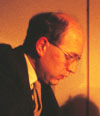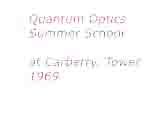
|
|
|
Dick's life with physics, page 5 |
|
|
|
|
|
The Sillitto-Haig experiment was carried out in a poorly insulated hut known as 'the old rifle range' just inside the Flodden wall of Drummond Street. Sandwiched between the hut and the main building was the 'crystal palace', a prefabricated system building - a periodic structure - erected to house the new Solid State group, many of whom had a background in crystallography. This influx of talent followed the return from Cambridge in 1964 of Bill Cochran, a friend of Dick's from their undergraduate years. Bill came to a new Chair of Physics; Norman Feather was still Head of the department as Professor of Natural Philosophy. The small Mathematical Physics group under Born's successor, Nick Kemmer, was now housed separately on the opposite side of Drummond Street. Student numbers also were increasing rapidly at the time, and the University decided that Physics and Mathematics should share a new building on the Kings Buildings campus a mile to the south. Meteorology, now a separate department, and Computer Science would be housed there too. Dick was deeply involved for a few years as a member of the committee which did the initial planning in collaboration with architect Hardie Glover of Basil Spence and Partners. In October 1961, Dick was the sole non-professorial member of a small working party appointed to assist the Principal in preparation for a visit from the Robbins Committee, which would be collecting qualitative views on some or all of
He was also a member of the Welfare Committee which always met in the evening because so many of its members were medical people. When geology professor Fred Stewart became Dean of the Science Faculty in 1965 he asked Dick to take on the work of Associate Dean, an office Dick was pleased to retain for a further two years when Hermann Brück succeeded Fred in 1968. This meant that Dick had to spend much of his time in the Faculty office at Kings Buildings. He became a member of many more committees, convening some of them, in the Faculty, the wider University and beyond. According to Aubrey Manning, "Dick was a big influence on the University in one of its golden ages". With Fred, he oversaw the creation of the departments of Geophysics and Science Studies. He inaugurated conferences for new lecturing staff; membership of the Scottish Universities' Council on Entrance for the next six years saw him traveling frequently, establishing links with colleagues in other institutions. He was also a member of the Senatus Academicus in the years of student rebellion and Gordon Brown as Rector. Ken Bowler recalls Dick's "integrity and plain commonsense in dealing with every aspect of university life". For many years thereafter he represented Edinburgh University on the Court of Stirling University. Since 1962 Dick had been external examiner for the Physics department at Dundee, and he continued in that role for a couple of decades. The 1960s saw his first invitations to act as external examiner for PhD students, from George Series in Oxford and Leonard Mandel at Imperial College. He valued particularly the work with Mandel, who later went to Rochester to collaborate with Emil Wolf. In 1966 Dick submitted a proposal to the Scottish Universities Summer Schools in Physics: Possible topics and suitable speakers were suggested. And so, the 10th Scottish Universities Summer School in Physics would be on Quantum Optics, co-directed by Dick and Peter Farago (who now held one of the newly introduced Personal Chairs) with Alastair Rae as Secretary. For three weeks in July 1969 the historic Carberry Tower in Inveresk was occupied by a dozen internationally renowned speakers and over 50 enthusiastic postgraduate researchers from 16 countries, with an intensive programme of lectures, seminars, and shared meals. It was not all work: Edinburgh lecturer Bill Taylor, who was on the organising committee as a Steward, arranged a showing of the film Culloden, lecturer and clarinet player Ron Mackie brought his quartet to perform classical music, and a group of Gaelic singers came another evening. The other Steward, Dick's PhD student Catherine Woods, organised transport for various outings - a trip to the Bass Rock was long remembered by those who went. Some of the Americans felt that the menu was rather low in protein, so they bought a sheep from a local farmer and arranged a barbecue. On the other hand, Jan Peřina and Richard Horak from Olomouc in Czechoslovakia (as it was then) found even the everyday food "too rich". Dick had invited Jan to attend and give a seminar when he found that a recent paper of Jan's contained some new results he himself had just derived; their meeting at Carberry was the beginning of a life-long friendship and fruitful long-range interaction, though it was to be 25 years before they met again. |
 
|
| Site index |